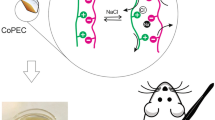Abstract
Currently, most wound dressings are therapeutically inert, lacking active components to aid in the wound healing process. In addition, production is based on mass subtractive manufacturing methods and does not allow personalised application. To address these issues, we explored the formulation of a composite gellan gum (GG)-hydroxypropyl methylcellulose (HPMC) hydrogel via additive manufacturing capable as a delivery vehicle for antimicrobials. Extrusion-based 3D printing was chosen as the mode of hydrogel production. Rheological tests were conducted to optimise the hydrogel formulation starting from a GG: HPMC ratio of 1:1 derived from previous studies. The optimal formulation, found to be 1 GG: 2 HPMC, was most able to recover from stress and display consistent time-dependent mechanical behaviour. The final 3D-printing conditions comprised of pneumatic pressure of 180 kPa, printhead speed of 5 mm/s and 25% infill density resulted in a 2 cm × 2 cm × 0.8 cm film. Subsequently, this formulation was tested as a delivery system for colistin, an approved peptide antimicrobial via agar well diffusion studies using Escherichia coli. Our results showed that our hydrogel formulation is an effective drug delivery vehicle and can be reproducibly printed to custom specifications. Taken together, this study demonstrates the feasibility of a customisable, “on-demand” therapeutic active hydrogel wound dressing for use in clinical settings.
Access this chapter
Tax calculation will be finalised at checkout
Purchases are for personal use only
Similar content being viewed by others
References
Tavakoli, S., & Klar, A. S. (2020). Advanced hydrogels as wound dressings. Biomolecules, 10(8), 1169. https://doi.org/10.3390/biom10081169
Nochos, A., Douroumis, D., & Bouropoulos, N. (2008). In vitro release of bovine serum albumin from alginate/HPMC hydrogel beads. Carbohydrate Polymers, 74(3), 451–457. ISSN 0144-8617. https://doi.org/10.1016/j.carbpol.2008.03.020
Ng, J. Y., Zhu, X., Mukherjee, D., Zhang, C., Hong, S., Kumar, Y., Gokhale, R., & Ee, P. L. (2021). Pristine gellan gum–collagen interpenetrating network hydrogels as mechanically enhanced anti-inflammatory biologic wound dressings for burn wound therapy. ACS Applied Bio Materials, 4(2), 1470–1482. https://doi.org/10.1021/acsabm.0c01363
Sultan, S., Siqueira, G., Zimmermann, T., & Matthew, A. P. (2017). 3D printing of nano-cellulosic biomaterials for medical applications. Science Direct: Current Opinion in Biomedical Engineering, 2, 29–34. https://www.sciencedirect.com/science/article/abs/pii/S2468451117300132
Milivojevic, M., Pajic-Lijakovic, I., Bugarski, B., Nayak, A. K., & Hasnain, M. S. (2019). Chapter 6—Gellan gum in drug delivery applications. In Natural polysaccharides in drug delivery and biomedical applications (pp. 146–186). Academic Press. ISBN 9780128170557. https://doi.org/10.1016/B978-0-12-817055-7.00006-6
Maškováa, E., Kubová, K., Raimi-Abraham, B. T., Vllasaliu, D., Vohlídalová, E., Turánek, J., & Mašek, J. (2020). Hypromellose—A traditional pharmaceutical excipient with modern applications in oral and oromucosal drug delivery. Journal of Controlled Release, 324, 695–727. https://doi.org/10.1016/j.jconrel.2020.05.045
Pan, Z., Ye, H., & Wu, D. (2021). Recent advances on polymeric hydrogels as wound dressings. APL Bioengineering, 5, 011504. https://doi.org/10.1063/5.0038364
Buwalda, S. J., Vermonden, T., & Hennink, W. E. (2017). Hydrogels for therapeutic delivery: Current developments and future directions. Biomacromolecules, 18(2), 316–330.
Conti, S., Maggi, L., Segale, L., Ochoa Machiste, E., Conte, U., Grenier, P., & Vergnault, G. (2007). Matrices containing NaCMC and HPMC. International Journal of Pharmaceutics, 333(1–2), 143–151. https://doi.org/10.1016/j.ijpharm.2006.11.067
Biswas, S., Brunel, J.-M., Dubus, J.-C., Reynaud-Gaubert, M., & Rolain, J.-M. (2012). Colistin: An update on the antibiotic of the 21st century. Expert Review of Anti-infective Therapy, 10(8), 917–934. https://doi.org/10.1586/eri.12.78
Gullberg, E., Cao, S., Berg, O. G., Ilbäck, C., Sandegren, L., Hughes, D., & Andersson, D. I. (2011). Selection of resistant bacteria at very low antibiotic concentrations. PLoS Pathogens, 7(7), e1002158.
Cheng, Y., Qin, H., Acevedo, N. C., Jiang, X., & Shi, X. (2020). 3D printing of extended-release tablets of theophylline using hydroxypropyl methylcellulose (HPMC) hydrogels. International Journal of Pharmaceutics, 591, 119983. https://doi.org/10.1016/j.ijpharm.2020.119983
Kirchmajer, D. M., Gorkin III, R., & in het Panhuis, M. (2015). An overview of the suitability of hydrogel-forming polymers for extrusion-based 3D-printing. Journal of Materials Chemistry B, 3(20), 4105–4117.https://doi.org/10.1039/c5tb00393h
Balouiri, M., Sadiki, M., & Ibnsouda, S. K. (2016). Methods for in vitro evaluating antimicrobial activity: A review. Journal of Pharmaceutical Analysis, 6(2), 71–79. https://doi.org/10.1016/j.jpha.2015.11.005
Gibson, B., Wilson, D. J., Feil, E., & Eyre-Walker, A. (2018). The distribution of bacterial doubling times in the wild. Proceedings of the Royal Society B: Biological Sciences, 285(1880), 20180789. https://doi.org/10.1098/rspb.2018.0789
Author information
Authors and Affiliations
Corresponding author
Editor information
Editors and Affiliations
Rights and permissions
Copyright information
© 2023 The Author(s), under exclusive license to Springer Nature Singapore Pte Ltd.
About this paper
Cite this paper
Pan, J., Lee, J., Cheong, R. (2023). Development of a 3D-Printable Hydrogel-Based Antimicrobial Film. In: Guo, H., et al. IRC-SET 2022. Springer, Singapore. https://doi.org/10.1007/978-981-19-7222-5_27
Download citation
DOI: https://doi.org/10.1007/978-981-19-7222-5_27
Published:
Publisher Name: Springer, Singapore
Print ISBN: 978-981-19-7221-8
Online ISBN: 978-981-19-7222-5
eBook Packages: Physics and AstronomyPhysics and Astronomy (R0)




